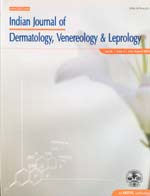
|
Indian Journal of Dermatology, Venereology and Leprology
Medknow Publications on behalf of The Indian Association of Dermatologists, Venereologists and Leprologists (IADVL)
ISSN: 0378-6323
EISSN: 0378-6323
Vol. 74, No. 6, 2008, pp. 611-613
|
 Bioline Code: dv08251
Bioline Code: dv08251
Full paper language: English
Document type: Research Article
Document available free of charge
|
|
|
Indian Journal of Dermatology, Venereology and Leprology, Vol. 74, No. 6, 2008, pp. 611-613
| en |
An Uncontrolled, Open label Study of Sulfasalazine in Severe Alopecia Areata
Aghaei, Shahin
Abstract
Background: Alopecia areata (AA) is an autoimmune disease mediated by T lymphocytes. Many treatments have been used but their results remain disappointing. There is a need to propose new therapeutic alternatives. Methods: During a period of 3 years, 26 patients with recalcitrant or severe AA (>40% hair loss) were enrolled in an open-label uncontrolled clinical trial. According to the response to sulfasalazine, patients were grouped into 3 categories: no hair regrowth (< 10% terminal hair), partial hair regrowth (10%-90% terminal hair), and complete hair regrowth (90%-100% terminal hair). Efficacy evaluation was performed with clinical examination. Results: Twenty-two patients completed the treatment. Overall, 68.2% (15 of 22 patients) responded to therapy: 27.3% (6 of 22 patients) achieved complete hair regrowth, and 40.9% had partial hair regrowth. Seven (31.8%) patients had no hair regrowth. Of the 22 patients with complete and partial remission, 10 (45.5%) suffered a partial or complete relapse. Side effects following treatment were seen in 7 (31.8%) patients. Conclusion: Sulfasalazine could be considered as a therapeutic alternative in the treatment of AA, because of its safety profile, cosmetically acceptable efficacy, and good tolerability.
Keywords
Alopecia areata, Sulfasalazine, Treatment
|
| |
© Copyright 2008 Indian Journal of Dermatology, Venereology and Leprology.
Alternative site location: http://www.ijdvl.com
|
|
